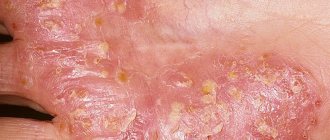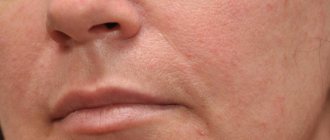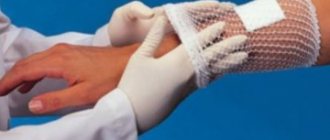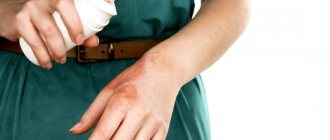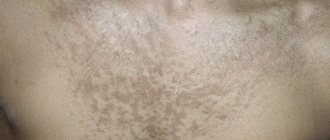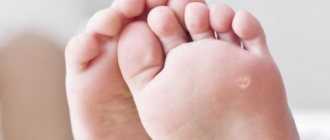Causes and mechanisms
Soft tissue compaction under the armpit is mainly of inflammatory or proliferative origin. This condition should attract attention and become a signal to find out the cause. It requires medical attention, and the first step will be to determine the source of the problem, which can be different:
- Hidradenitis.
- Furuncle.
- Lymphadenitis.
- Lymphadenopathy.
- Wen (lipoma).
- Metastatic lesions (breast cancer).
The cause may be damage to hair follicles, sweat glands, lymph nodes, and subcutaneous tissue. Moreover, this happens in men, women or children. In addition to the conditions described, edema of allergic or traumatic origin cannot be completely excluded. Therefore, before the examination, you cannot say for sure what is developing: a wen under the arm, an oncological tumor, or something else.
Places of occurrence of lipomas
Lipoma can appear on any part of the body covered with adipose tissue: arms, legs, head. Lipomas of the neck, eyes and internal organs also occur, but less frequently. Middle-aged and elderly women are at risk for developing wen. For a woman, a lipoma is a cosmetic defect, and therefore a cause for stress.
So, most often lipoma appears in the following places:
- In the chest. In 10% of women who are informed by doctors that they suspect breast cancer, a benign lipoma is excised. It is dangerous because it can degenerate into a malignant tumor called liposarcoma. Wen in the breast occurs due to blockage of the outlet channel of the sebaceous glands. A fatty lump in the mammary gland is not a defect, but a disease. It must be removed immediately.
- In the armpit area . The causes and treatment of this type of lipoma are determined by the doctor. The diagnostic process takes into account the presence of redness near the wen, its consistency, and pain. A suspicious lump may not be a lipoma, but a purulent inflammation of the sweat glands, popularly known as “bitch udder.” You will find more complete information on how to treat a knotted udder here. The source of the inflammatory process of this disease is staphylococcal purulent infection. Occurs in patients with diabetes, obesity and those who do not comply with personal hygiene standards.
- On the head. Lipoma of the scalp and forehead often occurs in young children. This type of wen is soft and mobile. The tumor must be removed before the child turns 5 years old. Lipomas on the head with a diameter of up to 3 cm are treated using a special absorbable medicine. The doctor injects it with a syringe into the wen. The result should be expected in a month. Large lipomas are removed from the scalp surgically. An article about wen in newborns addressed a similar issue.
- On the body. Wen on the body is classified into:
- ring-shaped - located along the neck;
- capsulated - in the form of fat capsules, affects internal organs;
- multiple – nodules are observed in several places throughout the body and hurt;
- tree-like - grows from a joint and puts down “roots”.
Symptoms
Each disease has certain characteristics that affect its symptoms. And the primary role in diagnosis is given to clinical examination. Based on the results of the survey and examination, the doctor forms a preliminary diagnosis, which becomes the basis for further measures.
Hidradenitis
Hidradenitis refers to purulent inflammation of the apocrine sweat glands. This disease mainly occurs in women, but men are also susceptible to a similar pathology. Microbes penetrate the ducts of the sweat glands due to microdamage (abrasions from shaving, scratching).
The most typical lesion is one-sided, when compactions form in the skin, accompanied by itching and pain when pressed. Next, the process becomes more explicit:
- Large nodes fused to surrounding tissues.
- The skin takes on a red-bluish tint and swells.
- Individual nodes merge into a single conglomerate.
- Severe pain occurs.
At the stage of maturation of hidradenitis, the clinical picture contains signs of systemic disorders (fever, malaise). Next, the central part of the infiltrate softens, the nodes are opened with the separation of thick contents - pus mixed with blood. Unlike a boil, there is no necrotic core. Once hidradenitis is opened, the general condition improves, an ulcer forms, which heals with scarring.
Hidradenitis is the most common cause of underarm lumps. But the doctor carries out differential diagnosis with other conditions.
Furuncle
A similar purulent-inflammatory disease is a boil. The process involves the hair follicle with surrounding tissues. During the period of boil ripening, a small red nodule is formed, which soon increases in size, taking on a cone-shaped shape. The formation is painful on palpation and during hand movements.
The maturation of the abscess is accompanied by an increase in local symptoms - redness, swelling and pain. A pustule forms in the center of the node, indicating the formation of a necrotic core (dead hair follicle). The process is accompanied by an increase in body temperature and malaise. Fluctuating masses soon break out, which, as with hidradenitis, leads to normalization of the general condition and reduction of pain. After cleansing of pus and necrotic areas, the wound heals with granulations.
Lymphadenitis
Another disease of inflammatory origin with which we have to differentiate a wen under the arm is lymphadenitis. The infection enters the node through direct contact with the skin (from the outside) or through vessels from other sites. In this case, typical signs of inflammation arise - local and general. The first include:
- Redness.
- Swelling.
- Soreness.
- Increase in local temperature.
Violation of the general condition is associated with fever and intoxication syndrome, which become most pronounced during an acute inflammatory process. Purulent lymphadenitis is accompanied by severe throbbing pain that occurs not only with movement, but also at rest.
Lymphadenopathy
Painless enlargement of lymph nodes that is not associated with inflammation is called lymphadenopathy. This is a condition that accompanies various diseases of a proliferative or infectious nature. Additional manifestations may be:
- Sweating.
- Fever.
- Emaciation.
- Weakness, etc.
Along with enlarged lymph nodes, the clinical picture in a child or adult often includes recurrent respiratory tract infections, hepato- and splenomegaly, as well as other symptoms indicating damage to one or another system.
Lipoma
A common benign tumor in the armpit is a lipoma. It is quite simple to distinguish it from inflammatory processes, since in this case there will not be the signs mentioned above. The growth of adipose tissue is completely painless and is often detected only after a targeted examination. The skin over the formation is not changed, the lipoma under the arm is not fused with the surrounding tissues, it is soft and elastic and has clear outlines. Discomfort may occur if the wen has reached a large size.
Various formations can occur in the armpit, including wen. But there are also more frequent processes.
Metastatic lesion
The greatest danger for women is when there is an enlargement of the lymph nodes in the armpit. This may indicate a malignant breast tumor - cancer. Metastatic spread of atypical cells is observed already at a fairly advanced stage. In this case, other symptoms of breast cancer are present:
- Volumetric education.
- Ulcerative defect on the skin.
- "Lemon peel"
- Nipple retraction.
- Pathological discharge.
- Breast deformity.
If we are talking about very late treatment, then cancer intoxication with exhaustion, weakness, pallor, lack of appetite and dysfunction of internal organs may be present. This is a very dangerous situation, the outcome of which, unfortunately, becomes unfavorable. Therefore, breast cancer always requires early detection.
Causes of swollen lymph nodes
Lymph nodes that become swollen due to infection are usually hard and painful. Because of the cancer, they are usually hard or stiff, immobile, usually painless, and may be attached to each other. Cysts and abscesses under the skin can form lumps that can be mistaken for enlarged lymph nodes.
Localized causes
- Injury to the armpit or arm.
- An infection in the armpit, arm, or chest that travels to the axillary lymph nodes.
- A disease caused by a scratch or bite from an infected cat. It usually resolves on its own without any specific treatment. However, the infection may be more severe in immunocompromised individuals, such as patients with HIV/AIDS, or in patients undergoing chemotherapy.
- A tumor in or near a lymph node.
- Breast cancer can cause swelling of the underarm lymph nodes.
- Melanoma is one of the most dangerous types of skin cancer. It can metastasize (spread) to nearby lymph nodes.
- Brucellosis is associated with muscle pain and swollen lymph nodes. It can present as an acute infection or become chronic and persist for many years.
- Silicone implants can cause the body to react to both the implant itself and its contents if damaged. Complications after breast augmentation may be accompanied by inflammation of the axillary lymph nodes, as well as swelling and chest pain.
- Perfumes, deodorants and some cosmetic procedures, such as hair removal, can also cause allergies or inflammation.
Systemic reasons
- Viral infections such as infectious mononucleosis, rubella, chickenpox and HIV/AIDS.
- Bacterial infection such as ascending lymphangitis, tuberculosis, cat scratch disease and lymphadenitis.
- A fungal infection that can appear after an injury, usually on the hands.
- Some side effects of vaccinations such as smallpox vaccination, typhoid vaccination and MMR vaccination.
- Increase in malignant neoplasms such as melanoma, leukemia, Hodgkin's lymphoma, etc.
Lipomas, as a rule, do not cause any concern to a person, but are a cosmetic defect. But, if the wen is located in the armpit area, then it is not always possible to distinguish it from an enlarged lymph node at home. A growing lipoma under the arm requires special attention from the patient and vigilance from the doctor.
Additional diagnostics
First of all, you need to establish what process caused the tumor under the armpit. But without a detailed examination this cannot be done. The set of diagnostic measures may include:
- Complete blood count (leukocyte count, red blood cells, ESR).
- Biochemical parameters of plasma (antibodies to infections, immunogram, tumor markers).
- Analysis of discharge (microscopy, culture, PCR).
- Ultrasound of the armpit.
- Mammography.
- CT scan.
- Lymphography.
- Biopsy of lymph nodes and breast tumors.
- Histological examination of tissue.
In each case, an individual examination plan is required. The patient may need to consult not only a dermatologist, but also a surgeon or oncologist. And based on the results of all tests, a final conclusion is made about the nature and causes of the condition that has arisen.
Diagnosis must be comprehensive, covering all stages of the development of the pathological process in the armpit.
Histological examination and prognosis
Biological material from a lipoma extracted from subcutaneous tissue is always sent for histological examination. The examination is carried out to determine the type of tumor: benign or malignant.
After surgery, in most cases the prognosis is favorable . A lipoma extracted from the mammary gland is examined especially carefully. There is a misconception that wen will disappear if you lose weight. But you should understand that a wen is a tumor, and not just subcutaneous fat. Without appropriate therapy it will not go away.
Treatment
After determining the source of the pathology, it is necessary to answer the next question - what to do with the formation under the armpit. It is necessary to get rid of not only local manifestations, but also the primary process that caused them. The range of treatments includes conservative and surgical methods. For inflammatory diseases, the following drugs are used:
- Antiseptics (boric acid, salicylic alcohol, brilliant green).
- Antibiotics (erythromycin, chloramphenicol).
- Immunopreparations (antistaphylococcal plasma, immunoglobulin).
During the period of infiltration, semi-alcohol wet-dry dressings, thermal procedures (UHF, UV), laser therapy, electro- and phonophoresis of drugs can be performed. When suppuration of the infiltrate has occurred, the only method of correction will be surgical - opening the node, draining and cleaning the wound. Further healing is carried out while taking antibiotics and ointment dressings.
Lymphadenopathy is treated by affecting the underlying process - infection or hematopoietic pathology. Various medications help in this matter: antibiotics (including antitumor), antiviral, cytostatics, corticosteroids, immunomodulators. Hodgkin's disease and leukemia also require bone marrow transplantation.
Wen under the armpit, which is small in size, does not require treatment. When the tumor interferes with the movements of the upper limb and creates discomfort, it is removed. But with breast cancer, the situation requires a more radical and comprehensive correction. The following areas help cure oncology:
- Operation.
- Radiation therapy.
- Chemotherapy drugs.
- Hormone therapy.
- Targeted treatment.
The effectiveness of therapy for a malignant tumor is determined by the time of its onset (i.e., the stage of cancer) and individual characteristics (sensitivity to hormones). Of course, the first aspect largely depends on the woman herself and the regularity of preventive examinations.
How to get rid of wen?
You should not self-medicate, especially if the lipoma appears on the neck.
Popular lipoma removal methods:
- Surgical. After surgical removal of the lipoma, scars remain in place. Depending on the characteristics of the human body, the postoperative period is 15-25 days. First, the place where the lipoma was is covered with a crust. It is not recommended to scratch or wet it. Here we covered the issue of removing a wen on the back.
- Removal at home. Sometimes patients decide to pierce the wen at home on their own. This applies to small wen on the eyes. But it is worth considering that this procedure is risky and fraught with unpleasant consequences: the wound may become infected or the face may remain disfigured. So even such a small operation should be entrusted to professionals.
- Puncture-aspiration removal. During the procedure, the doctor inserts a needle into the lipoma and sucks out the contents. But it is not always possible to clean the capsule completely. Even microscopic amounts of lipoma material can grow. A similar method is used for drug treatment of lipoma. The doctor inserts a syringe into the tumor, but does not suck it out, but injects a medicinal solution into it.
- Laser therapy is a new method of painless treatment of lipomas. After laser therapy, the wound heals within 15 days without scars or marks. The laser acts at the cellular level. In 4 minutes, the tumor and its capsule disappear completely, healthy neighboring tissues remain intact. The carbon dioxide laser simultaneously removes the tumor and disinfects the surgical site. Unlike laser removal of moles, the wen is not destroyed during laser therapy. It can be sent for histological examination.
- Electrocoagulation is the removal of wen with low-frequency current. A popular method in cosmetology. The current is directed around the wen, and it is rejected along with the capsule. There are no scars or traces left after electrocoagulation. A pigment spot may appear, which will disappear within a few months. Small lipomas are removed using electric current without anesthesia. This method is prescribed if it is necessary to eliminate several nodules located on the surface of the skin at once.
Traditional treatment
The effectiveness of using recipes from traditional healers is controversial. Lotions, masks and compresses act more like self-hypnosis. Sometimes they can cause harm.
Traditional recipes:
- Sour cream mask is popular : high-fat sour cream, honey, and salt are mixed, heated a little and applied to the lipoma. Keep the mask for 30 minutes, repeat every other day for 2 months.
- Egg film . Cover the wen with film from a hard-boiled egg. The tumor may become red and swollen, but the swelling will soon disappear. Use until the wen disappears completely.
- Grind the golden mustache leaf Repeat the procedure in the morning and evening for 14 days.
- Eat one and a half tablespoons of cinnamon ; cinnamon breaks down fats and can cure internal lipoma.
- fresh Kalanchoe leaves to the wen with a bandage. Change the bandage with the plant every day. You can apply coltsfoot in the same way.
- hot lamb fat into the lipoma . It is recommended to do a 15-minute hot fat massage every day. Sometimes the tumor disappears after the first procedure.
- phytolacca berries (American laccone) until it completely disappears. The course of such treatment can last several months.
Prevention
To prevent tumor formations in the armpit, it is necessary to follow preventive recommendations. They include the elimination of factors contributing to the development of the diseases in question. It is worth paying attention to the following measures:
- Maintain personal hygiene.
- Proper nutrition.
- Healthy lifestyle.
- Reduced sweating.
- Careful depilation.
- Regular medical examination.
- Timely consultation with a doctor.
These measures are general in nature, but can prevent many problems associated with the development of pathology under the armpit. And every person at risk should pay attention to them.
Neoplasms of an inflammatory and proliferative nature require high-quality treatment, and preventive measures will help prevent them.
Swelling in the armpit is a common symptom experienced by patients of all ages, men and women. It may be associated with various pathologies of a local or systemic nature. Therefore, only a doctor can find the source of the problem and tell how to treat the condition that has arisen.
What is a lipoma in the armpit?
The tumor consists of mature fat cells - adipocytes. Under the influence of factors not yet established by science, adipose tissue begins to grow inside a thin fibrous capsule. The neoplasm belongs to the group of benign ones; its removal is carried out to restore the aesthetic appearance of the skin.
Attention! A small, harmless tumor can grow significantly larger and put pressure on nerves and blood vessels.
A lipoma under the armpit causes discomfort to a person more often than other benign formations. It is difficult to move the arm in the shoulder area. The fatty tissue presses on the lymphatic ducts and nodes, capillaries and large vessels. As a result, microcirculation is disrupted, and then the blood supply to the affected area of the body.
Lipoma in the armpit: photos, signs, complications
Popularly, wen is considered a fairly safe disease and is often eliminated on its own. However, such a frivolous attitude towards the anomaly is the height of carelessness - under this harmless name lies nothing more than a real oncological lump.
It is a mistaken belief that oncology is only about cancer diagnoses. Absolutely all neoplasms, regardless of the nature of their appearance, require observation and timely treatment, since the risk of their cellular degeneration is quite high.
Medical certificate
An axillary lipoma (in medical terms, a mesenchymal tumor) is an oncological neoplasm of a benign nature, having a fibrous capsular membrane and consisting of adipose tissue.
It is formed in the layer between the skin and muscle layers; when localized in the axillary zone, it can cause serious harm to health. It has pronounced boundaries and becomes deformed when pressed.
The pathology is felt as a compaction, which, once it reaches a certain size, can be easily felt by palpation. As the tumor grows, it can cause its “owner” a lot of physical trouble, including severe pain. The reason for the phenomenon is the pressure exerted by the seal on neighboring blood vessels and lymph nodes.
At the initial stages of disease progression, the patient may only feel discomfort when trying to make sudden movements with the hand, then even a slight movement of it causes pain.
A feature of the development of axillary lipoma that distinguishes it from pathologies localized in other parts of the human body is its tendency to grow rapidly and the ability to reach quite large sizes.
In addition, this area is specific for the concentration of a large number of sweat glands, and the accumulation of fluid secreted by them on the surface of the skin creates favorable conditions for the development of inflammatory processes and disruption of the structural content of cells, up to their degeneration, which further aggravates the situation.
Classification
Depending on the structure and nature of the tissues, which are in the majority in the tumor, axillary wen is classified into the following types:
- lipofibroma is the most harmless tumor, consisting almost entirely of fat cells. It is much softer to the touch than other types of the anomaly in question, which makes it possible to accurately diagnose it. Rarely mutates into cancer, however, it can reach large sizes;
- fibrolipoma - more than 70% of the composition is fibrous tissue. The component has a fairly dense structure, the capsule retains its shape when pressed, grows slowly, but is more prone to malignant cell mutation than other pathologies;
- angiolipoma - its approximate percentage composition is as follows: 45% fat layer, 50% connective tissue, and 5% blood vessels and capillaries. You should not try to remove such a tumor yourself, since there is a high risk of internal infection and the development of an abscess. May be accompanied by severe pain;
- myolipoma is the rarest form of neoplasm. It is diagnosed extremely rarely, which is why its etiology is poorly understood. Consists entirely of muscle fibers. It almost never degenerates into cancer and is not prone to progressive growth. May dissolve on its own.
The difference between a lipoma and an inflamed lymph node
It is quite difficult to independently distinguish these two completely different ailments, but there are signs by which this can be done with a high degree of probability.
Inflammation of lymph nodes almost always causes pain even with friction; it differs in skin pigmentation - the lesion acquires a reddish tint, and the node itself is somewhat larger in diameter than a lipoma.
Complications
In the vast majority of cases, this diagnosis does not cause serious health complications, provided that the pathology is constantly monitored and, if necessary, quality medical care is provided.
The probability of cancerous degeneration of a tumor in the armpit is no more than 10%. However, located in this zone, it is fraught with the following complications:
- constant discomfort during friction;
- at advanced stages of the disease - inconvenience , and in some cases - constant pain;
- the development of axillary lymphedema , as a concomitant diagnosis, is a consequence of constant pressure on nearby lymph nodes.
Methods for removing atheroma
Such neoplasms are treated using operations such as laser and radio wave exposure and classical surgery. Radio wave destruction is considered the most effective and safe, as it does not require subsequent sutures. The operation has a short recovery period and good cosmetic effect. Is it possible to get rid of atheroma without surgery?
No ointments, lotions or tablets can eliminate a sebaceous gland cyst. Attempts to squeeze out its contents do not bring positive results either. The atheroma shell remains in place and continues to produce contents. In addition, opening the atheroma with non-sterile instruments can provoke inflammation, which will require urgent surgical intervention. There are no specific preventive measures. It is believed that atheromas most often occur in people suffering from hyperhidrosis or having oily skin. Regular hygiene procedures using products that reduce sebum secretion help prevent the development of benign tumors. Equally important is proper nutrition; you must avoid eating fatty and fried foods, coffee, and alcohol.
be careful
7 out of 10 people are infected to some degree with the human papillomavirus (HPV).
HPV cannot be ignored, because cancer is the most important and dangerous consequence of the papillomavirus.
One of the few natural drugs that does not harm the liver and gallbladder is Papinol. This drug is not sold in pharmacies and is not advertised on the Internet, and according to the promotion it costs only 147 rubles.
When atheroma occurs under the arm, it can cause a person significant discomfort. First of all, this part of the body is almost always in constant contact with clothing. This can cause the bump to rub, resulting in pain. Despite the fact that atheroma is not a malignant neoplasm, it is prone to inflammation and infection.
Is it worth treating asteroma at home?
As mentioned above, not all people are ready for surgery or the atheroma is very small in size. Sometimes inflammation of the atheroma occurs with its suppuration, it can even ulcerate. Then the specialist can prescribe its treatment, which the patient carries out at home independently. Or those who are more fearful begin to turn to traditional medicine.
However, it should be remembered that when atheroma is inflamed, self-medication is useless and often dangerous.
Still, you should visit a surgeon to get qualified help. There are not many ways to cure atheroma yourself at home.

